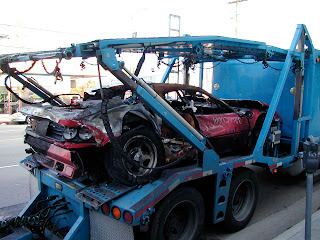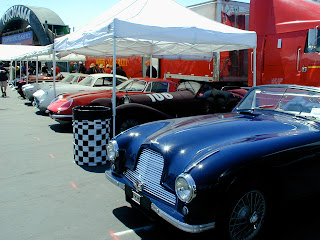

Because the discovery of the Montgomery books had had such an impact on me, I was now stopping by every book store that I saw- looking for more of this info. I even went to our public library which, I'm sorry to say, was pretty rare for me. I kept coming up short, and it was beginning to look like it was going to be me and these couple of hot rod scrapbooks for a while.
Then, one day, there it was. What I think is undoubtedly the holy grail on this subject; "The American Hot Rod" by Dean Bachelor. If you were going to limit yourself to just one book on the subject, you could do no better than this. First and foremost, the late Dean Bachelor was a very fine writer. He had experience as an automotive journalist that few in the field could approach, he worked for a wide range of publications and could write about nearly every facet of the sport, and could use his first hand knowledge of the subject matter to really firm up the credibility of a piece.
Although he could write about Ferrari with the best of them ( he was the long time owner of a 340 Mexico ), we would find out in early 1995 that Dean Bachelor grew up in southern California in the 1940s, had an early interest in speed, and was out on the dry lakes as soon as he was able in a hot rod roadster of his own construction... right along side all of our hot rod pioneers. Dean was one of the founding members of the famous "Road Runners" roadster club and an early SCTA member, all before the onset of WW2. He had one of the nicer '29 on a '32 street/competition roadsters that ran back then, and it was competitive too. He also built and ran a long line of modifieds, lakesters, and streamliners. He was instrumental in starting the So-Cal Speed Shop with close friend Alex Xydias and, together with Alex, built one of the best looking, finest designed streamliners of early Bonneville which ran an astonishing 193mph in 1949 using Ford flathead power. Oh and it keeps going; Dean was the official photographer for the Pebble Beach Concours for over 20 years and his level of excellence as a writer earned him the honor of having an award named after him... the "Dean Bachelor Award", which is given out each year for the finest automotive publication. Oh, and as long time editor of Road and Track magazine, Dean is largely credited for establishing that brand and making R-n-T what it is today.
So we had a good man on the scene to be writing about the history of hot rodding. And a fine job he did. It seems somehow appropriate that Dean passed away just as he was putting the final touches on this book. This was, after all, the story of his childhood, teenage, and early adult years. And somehow, with a lifetime of automotive writing under his fingertips, he had never tackled the subject of the very thing that had given him his addiction to speed. In the book, it almost feels like he had so much he wanted to do for this that he saved it until the end. A colleague and close friend of Bachelor's states in the book's forward,"This is Dean's book. This is the book that he talked about writing his entire life."
The book is so thorough in its documenting of hot rod history every step of the way, that it is truly awesome. Who could have ever guessed that guys were building and racing jalopies out on the California dry lakes as early as the late teens? And more striking is the fact that there are grainy old photos of these happenings! How about a photo of the first known speed shop, Lee Chapel's, from 1932!!!??? He is able to take you through the entire history of it from inception through every era and movement, even when these pockets of time were 3-4 years or less. I do know that the first time I read it I thought it should be used as a formal text book if and when the history of hot rodding would ever be an elective... and I mean that as a compliment. It is that detailed.
This was what I'd been waiting for. Here, in front of me, was the story AND the characters. The real live history of hot rodding. You can imagine how quickly everything else in my world stopped when I found this. I know I read it cover to cover the first day I had it, and continued to go back and re-read it over the next few months. Slowly I started to not only get a handle on the story and the names behind it all, but I began to get a true feel for how this happened. It was really making sense to me. Almost feeling like there wasn't a choice for the lucky young guys who lived out there during these early days. Money and entertainment were scarce, the cars were cheap and plentiful, and ( especially after the war ) - thrills were scarce... certainly compared to what a lot of these guys had just been through. The greatest race courses for flat out top speed runs were all around them and free to run on. Again, it would have been strange if it hadn't happened.
Last but not least were the great names and characters populating this book and the stories within. Truly amazing accomplishments being performed by kids. Kids. Not young adults, but kids. Late teens early twenties. This seemed to be the age group that was getting everything done. Inventing all the componentry, inventing the speed equipment and companies that would become the standards of the industry to this day. Pulling off daredevil-like feats behind the wheels of exceedingly unsafe and homemade machines. Raising the standards of what was considered fast several times a year and ultimately bringing the world land speed record back home to the United States. Proving to the rest of the country that what may have started as a youth movement steeped in danger and rebellion would develop into a very well organized community that promoted safety and innovation, and would have its effects felt all throughout the automotive world in the years to come.
These were some pretty impressive kids. And as is the case with anything you read or follow, some players begin to stand out to you more than others. For whatever reason; personal taste, style, a common interest with what the person's specialty might be, whatever the case, you just start to find yourself paying closer attention to what a couple of folks in particular are up to and accomplishing. With every reading of the book I began to pick out some of my favorites. It was hard to choose, but again, they find you.
One guy in particular was really impressive to me. As I've said before, I like the enthusiasts who have a wide interest. Dean Bachelor was certainly this way, and so was one of the guys that seemed to be getting a lot of ink in this book. He was an early hot rod pioneer for sure, dry lakes racer, renown engine builder working alongside the best guys there were at the time, was in on the beginning of drag racing as a successful builder and competitor, he even built a series of Ford based American road racing specials using all that he'd learned from his engine building and chassis building days... and this was all accomplished by this kid during a span of about ten years!
What was his name you might ask???, well, you may just have to tune in tomorrow to not only find that out, but hear about my first hot rod safari out to So-Cal looking for any of these guys that might still be around. I think you'll be surprised by how lucky I got. I know I was.
( The photos above would be of my original dog-eared copy of Dean Bachelor's "The American Hot Rod" , and of course Dean himself in his beautifully turned out roadster about to push off down the salt. )









































